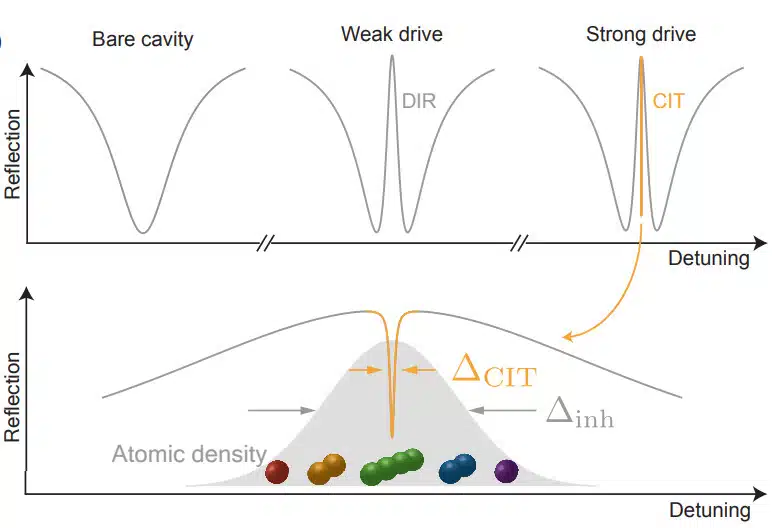Researchers discover a phenomenon that makes atoms transparent

Artist's impression of a laser hitting atoms in an optical cavity. | Ella Maru Studio
A Caltech team recently discovered a phenomenon called “collectively induced transparency” (or CIT ) , which occurs when a group of atoms suddenly stops reflecting light at specific frequencies. This discovery could lead to new applications in quantum computing, including the development of more efficient quantum memories.
Cavity quantum electrodynamics (EQC) is the study of the interaction between light confined in a reflecting cavity and atoms (or other particles), at the most fundamental level, under conditions where the quantum nature of photons is significant. This area of research has benefited from great experimental advances over the past decades, thanks to the development of micro- and nanoscopic devices and laser trapping techniques, the researchers note. The progress made has led to the application of EQC to quantum information processing.
Indeed, the ability to alter the properties of emitters with light (and vice versa ) has proven to be an indispensable tool for highly controlled quantum operations, the team explains. Previous work has focused on EQC in multi-emitter systems, which were in the form of atomic gas. Here, researchers set out to examine light-matter interactions with rare-earth ions embedded in solids (with the solid-state implementation offering the possibility of on-chip integration in quantum applications). It was then that they discovered a clear window of transparency in the reflection spectrum of the optical cavity.
“ We didn't know this window of transparency existed. Our research has first and foremost become a journey to find out why ,” said Andrei Faraon , professor of applied physics and electrical engineering at Caltech and co-author of the paper reporting the discovery. For their experiments, Faraon and his colleagues confined approximately one million ytterbium atoms embedded in yttrium vanadate (YVO 4 ) inside a tiny optical cavity (or optical resonator) — a mirror device in which certain light rays remain confined by successive reflections. They bombarded these atoms with a laser beam.

Schematic description of the cavity-ion interaction.
The optical resonator was fabricated at Caltech's Kavli Nanoscience Institute; it is only 20 micrometers long and has features smaller than 1 micrometer. This extraordinary device allowed them to make an unprecedented discovery. " Using conventional quantum optics measurement techniques, we found that our system had reached an unexplored regime, revealing new physics ," said Rikuto Fukumori, quantum information science researcher and co-author of the paper. 'study.
Groups of atoms continuously absorb and re-emit light. So, as expected, the laser light seemed to "bounce" off them. However, the team found that this only happened up to a certain point: they discovered that with a certain frequency, a "transparency window" appears. The light then simply passes through the cavity, unhindered.

(top) Reflection spectrum of a cavity without ions showing the resonance of the empty cavity (left), with weakly entrained ions (middle), and with strongly entrained ions (right). (bottom) Zoom on the part of the spectrum showing the CIT.
By analyzing this window of transparency, they were able to elucidate the phenomenon which was at its origin: it turns out that the latter is similar to destructive interference - which occurs when two waves, coming from different sources and from the same amplitude, overlap while they are out of phase (their extremes cancel each other out). In this experiment, the groups of atoms reflect the laser light continuously, but at the frequency of CIT, the light re-emitted by each of the atoms of a group creates an equilibrium, which will cause a drop in the reflection.
Superradiant lasers and more efficient quantum memories
“ We were able to monitor and control quantum mechanical light-matter interactions at the nanoscale ,” summarizes co-author Joonhee Choi, a former postdoctoral researcher at Caltech and now an assistant professor at Stanford University.
Apart from the transparency phenomenon, the researchers also observed that the set of atoms can absorb and emit laser light much faster (or much slower) than a single atom, depending on the intensity of the laser. . These processes, called “superradiance” and “subradiance” respectively, and their underlying physics are still poorly understood due to the large number of interacting quantum particles. “ Their observation represents a key step towards the creation of ultra-fine linewidth superradiant lasers and long-lived solid-state subradiant memories ,” the researchers point out in their paper.

This work expands our understanding of the mysterious world of quantum effects and could one day pave the way for more efficient quantum memories, in which information is stored in a set of tightly coupled atoms. Andrei Faraon has already worked on creating quantum memories by manipulating the interactions of several vanadium atoms.
The CIT discovery could also help to implement quantum networks: " Apart from memories, these experimental systems provide important insights into the development of future connections between quantum computers ," said Professor Manuel Endres, another co-author of the study.
Source : websites

